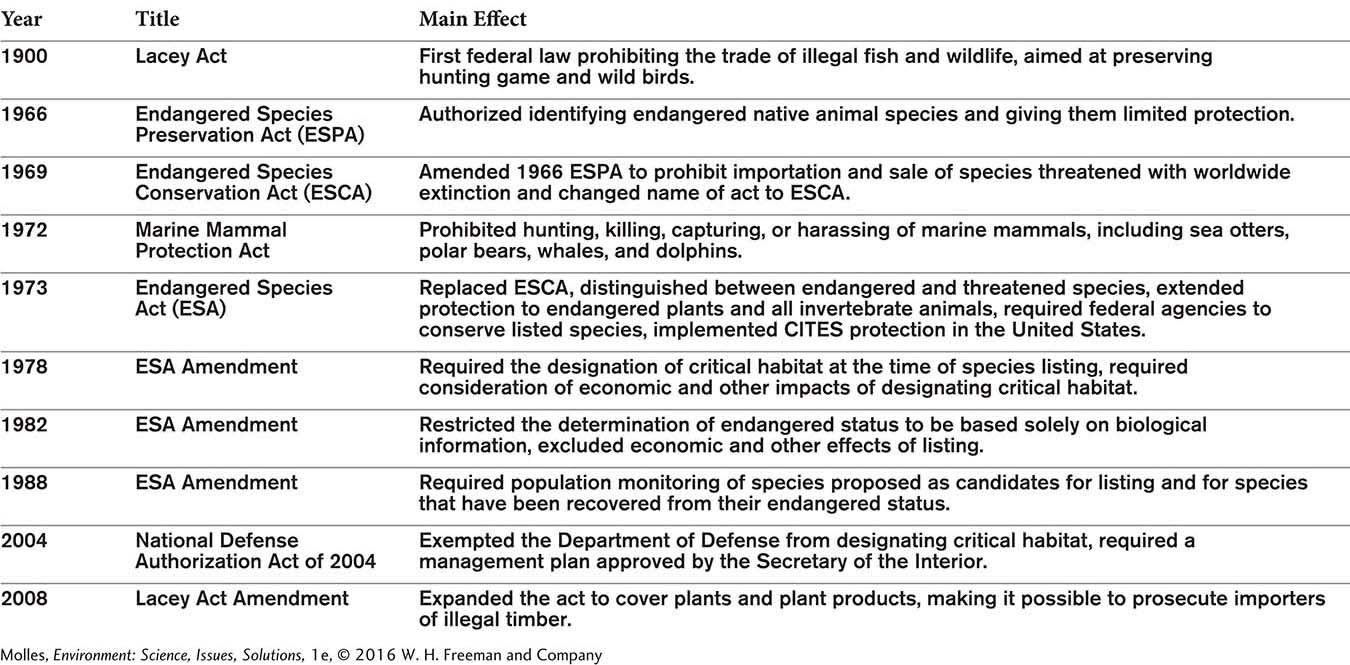3.10 National laws and international treaties protect endangered species
3.10–
82

Can laws, such as those protecting endangered species, be effective if they do not reflect the prevailing values of society as a whole?
How can we possibly reverse the sixth mass extinction? In 2013 National Geographic magazine ran a controversial cover story titled “Reviving Extinct Species.” It was not a work of science fiction, but an exploration of genetic technologies that are edging closer to reconstructing life from bits and pieces of DNA found in bones, hair, and other pieces of fossilized or preserved material. Imagine woolly mammoths from the Ice Age walking Earth again! Or how about reviving the passenger pigeon, which once numbered in the billions and was wiped out by hunting?
While genetic resurrection may be useful in bringing back a handful of the most spectacular and important animals on the planet, it is hardly a viable solution to the biodiversity crisis. Even if all the species that human activity has destroyed thus far were effectively brought back, the threats that hindered their survival in the first place still pose great danger. In the foreseeable future, it is likely to be far cheaper and easier to prevent an extinction than to try to reverse one. The first step involves establishing a legal framework to protect species.
Endangered Species Act of 1973 (ESA) Legal protection in the United States for both domestic and foreign endangered species that declared plants and all invertebrate animals eligible for protection.
While laws regulating the hunting, fishing, and trapping of wildlife have a long history, it was not until rather recently that fears of species extinctions resulted in legal protection. The Endangered Species Act of 1973, or ESA, provides legal protection in the United States to both domestic and foreign endangered species and declares plants and all invertebrate animals eligible for protection.
critical habitat Areas that are essential for the survival of a listed endangered or threatened species.
In addition, the ESA requires federal agencies to develop programs for the conservation of two categories of species: endangered species, which face the highest danger of extinction, and threatened species, which face a lower danger of extinction. Agencies are also prohibited from authorizing, funding, or engaging in any action that would jeopardize an endangered or threatened species or that might destroy or alter so-
83

Protection of endangered species and their critical habitats often clashes with economic activities. An endangered fish called the snail darter prevented a dam from being built in Tennessee for many years, while the Northern spotted owl has blocked the cutting of old growth forests in the Pacific Northwest. As a consequence, a variety of economic interests have tried repeatedly to weaken the Endangered Species Act, in part by limiting the funding that gets appropriated to it each year.
Nevertheless, the law has been remarkably successful in conserving and restoring a wide variety of species. Approximately 1,400 species in the United States and 2,000 globally have been listed and placed under the protection of the ESA. Some of the most well-

The CITES Treaty
The major treaty regulating international trade in wildlife is the Convention on International Trade in Endangered Species of Wild Fauna and Flora, or CITES (pronounced “sight-

How can communication and education complement the laws and treaties protecting endangered species?
Lacey Act First passed in 1900 and amended in 2008, this law forbids trade in illegally harvested plants and animals.
The nations that have signed CITES and many prominent nongovernmental organizations, such as the World Wildlife Fund or World Wide Fund for Nature (WWF), Conservation International, and the Wildlife Conservation Society, are cooperating to reduce wildlife trafficking and the threat it presents to endangered species. In the United States, one of the critical tools to enforcing CITES is the Lacey Act. First passed in 1900 and amended in 2008, the Lacey Act forbids the trading of illegally harvested plants and animals. For example, if an endangered ebony tree is illegally harvested in Madagascar, outside of U.S. jurisdiction, one can still be prosecuted for importing it to or trading it in the United States. In 2012, for instance, Gibson Guitar pled guilty to importing ebony for its guitars in violation of the law.
Think About It
How might including the potential for negative economic impact as a criterion for the listing of endangered species affect how the ESA is applied?
Why is it critical to have both national laws and international cooperative treaties regarding trading in endangered species?
84